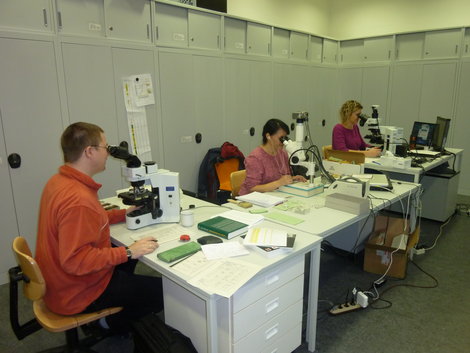Micropaleontology
The lab is equipped with a hot plate under hood, a variety of permanent mounting media, and supplies (petrographic slides, cover glasses, sieves, sampling tools, etc.) for the preparation of smear slides.
Smear slides are permanent mounts of fine (silt- and clay-sized) granular sediment. Smear slides are generally made from samples of well-sorted, fine-grained clastic and biogenic sediments (mud, ooze, micrite, etc.). They can also be made from the fine-grained fractions that are mechanically extracted (by sieving) from more poorly sorted sediments. Marsaglia et al.(2013) prepared a smear slide atlas and tutorial on behalf of IODP Management International (IODP-MI), Inc. The goal of this tutorial is to convey the essentials of the smear slide method to sedimentologists engaged in marine core description on board IODP drilling vessels or at IODP core repositories.
Study of this tutorial will help core describers develop and apply solid skills
in the identification and semiquantification of mud components.
IODP Video (Feb 2017): A Guide To Smear Slides
Marsaglia, K., Milliken, K., and Doran, L., 2013. Smear Slides of Marine Mud
for IODP core description, Volume I. Part 1: Methodology and Atlas of
Siliciclastic and Volcanogenic Components. IODP Technical Note 1.
doi:10.2204/iodp.tn.1.2013
Smear Slide Digital Reference for Sediment Analysis of Marine Mud. Part 2:
Methodology and Atlas of Biogenic Components. IODP Technical Note 2.
doi:10.14379/iodp.tn.2.2015
1. cover glass (24 x 40 mm) - #1 thickness
2. toothpick
3. water dropper
4. glass petrographic slide (25 x 75 mm)
5. permanent mounting medium
6. glass rod
7. hot plate
8. tweezers
9. pencil with new eraser
10. slide label
The hot plate is located under a hood. The hot plate should be set constantly on "low." A small beaker or uncapped bottle of mounting media is usually kept on (if appropriate, to reduce its viscosity) or near the hot plate under the hood at all times.
To make a smear slide take a cover glass in hand and place a few drops of distilled water in its center. Collect a tiny fraction of the sample with the flat end of the toothpick, and mix it into the water on the cover glass. Spread the wet sediment with the flat end of the toothpick until it forms a thin translucent coat across the entire cover glass, and then place the cover glass (with the sediment smear up) on the surface of the hot plate to dry.
While the smear on the cover glass dries, place a slide label on the glass petrographic slide, and label it with the expedition site, hole, core, core, type, section, and sample interval data. Place a few drops of mounting medium in the center of the petrographic slide with the glass rod, and set
it on the surface of the hot plate to warm. When the smear on the cover glass is dry, use the tweezers to place the cover glass (with the sediment smear down) on the mounting medium on the petrographic slide. Press down and slowly rotate the cover glass with the clean eraser-end of the pencil
to spread the mounting medium across the petrographic slide and to expel gas bubbles. If there is not sufficient mounting medium to cover the entire smear, use a clean toothpick to drip one or two drops of mounting medium
onto the petrographic slide at the edge of the cover glass, where they will be drawn by capillary action under the cover glass. Finally, return the smear slide to the hot plate for 3-5 minutes to allow it to cure.
Thin sections of selected samples will be made on request.



